After Chuck’s first article on the Conti GP 5000 tires, we knew we had to have him back to write on the GP 5000 TL. If you haven’t read the previous article. You can read it here .Chuck Peña is a former weekend warrior racer who now just rides for fun and coffee (as well as the occasional taco), but every once in a while manages to prove Fausto Coppi’s adage true: Age and treachery will overcome youth and skill. He lives in Arlington, VA with his wife (who is his favorite riding partner), his daughter (who takes great joy in beating him at golf all the time, but at least he’s still faster on a bike), and their dog (who is always there to greet him when he comes home from a ride). You can follow him on Strava, Twitter, and Instagram. Chuck is also a contributor to PEZ Cycling News.
Everyone knows the Irwin AON TLR series road bike wheels are tubeless ready (hence, the TLR moniker). But when I became an Irwin Ambassador last year, I decided to ride my AON TLR 38s with tubes. (My previous wheels – Shimano RS81 C35s – were also tubeless ready, but I rode them with tubes too.) Why? Because (at least for me) tubeless seemed like a solution in search of a problem. In the six years I’ve been back on the bike after a 15 year hiatus, I’ve had all of four flats. The first was a sidewall gash that probably wouldn’t have been saved by a tubeless set up (and was probably the result of riding tires that should’ve been replaced). The second was a pinch flat (totally my fault because I probably rushed installing the tube the night before) when I hit a sharp speed bump, which a tubeless set up would’ve averted since there would be no tube to pinch. The other two were punctures due to a glass shard and a staple – the type of punctures that sealant would’ve plugged.
Even though tubeless would’ve saved me on three out of four occasions, I still wasn’t convinced that road tubeless was worth doing. Largely because it seemed like a hassle (hey, tubes are easy!) and the potential mess of sealant (I’d heard horror stories of sealant spraying everywhere).
But when Irwin offered me the chance to have a go on the new Continental Grand Prix 5000 tubeless tires, how could I not? After all, the pros are beginning to embrace road tubeless. Alexander Kristoff won Gent–Wevelgem riding Vittoria tubeless tires (but experienced flats at Paris-Roubaix with tubeless). Peter Sagan was spotted riding Specialized tubeless tires at the Tour Down Under. And the Deceunick-Quick Step team has lined up riding Specialized tubeless tires at several races (including Fabio Jakobsen winning stage 4 of the Amgen Tour of California). As with disc brakes, it’s probably just a matter of time before we see more and more pro riders and teams on tubeless tires. I may not be pro (not even close), but who doesn’t want to feel and look like one, eh?
About the tires
The Continental Grand Prix 5000 is the latest incarnation of the venerable Grand Prix 4000 line on tires, which has had a loyal following for over a decade and is considered by many to be the gold standard of clincher tires. Continental claims the GP 5000 has less rolling resistance, better puncture resistance, and better mileage wear than the GP 4000. According to Continental, the BlackChili compound provides excellent grip and reduced rolling resistance without sacrificing durability, and the Vectran Breaker belt is supposed to be stronger than steel to offer high puncture resistance – both improved over the Grand Prix 4000. And the Lazer Grip shoulder tread is supposed to provide additional cornering grip.
What’s really different about the Grand Prix 5000 than the 4000 is that the 5000 is offered as both a regular clincher and tubeless tire, the Grand Prix 5000 TL.
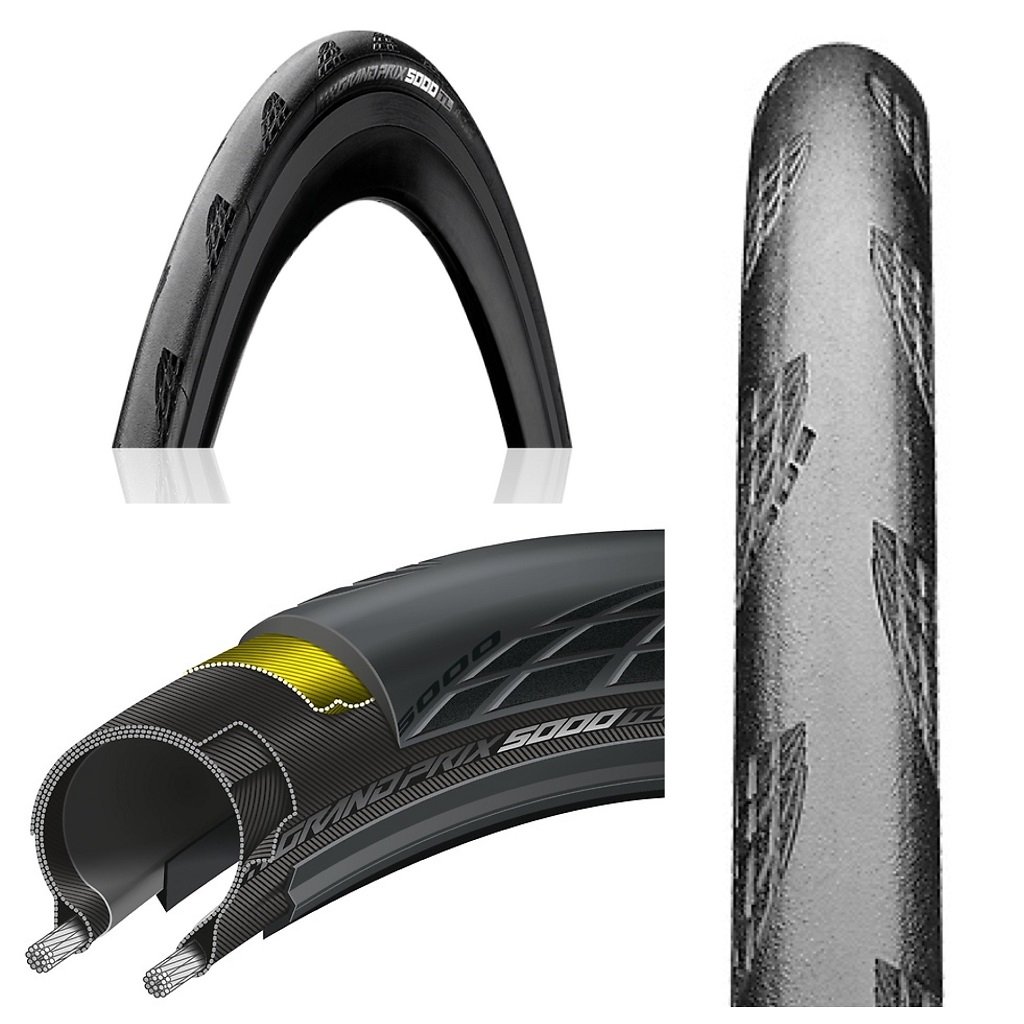 Continental’s latest and greatest road tire
Continental’s latest and greatest road tire
Installing the tires
If changing a flat tire with regular clinchers is something you find daunting, you will want to take your wheels and tires to your LBS and have them do this. Believe me, it will be money well spent. (I don’t know what’s reasonable or not in terms of cost, but I know one LBS in my neck of the woods charges $35 per tire/wheel.)
But if you want to DIY, I’ll provide a little bit of detail of what’s involved.
The AON TLR carbon fiber wheels come with tubeless rim tape already installed. However, in doing my research about tubeless tires, I’d read that sometimes a tubeless tire wouldn’t seat or hold air on a rim (even though the rim was a tubeless ready rim). The reason for that is because there isn’t an industry standard for tubeless rims and tires sometimes a particular tire might not work on a particular rim (although we might be getting close to having a road tubeless standard). I think this is pretty rare but it’s something you need to be aware of. In those cases, a second layer of rim tape was often the cure. So even though it might be overkill, out of an abundance of paranoia I added a second layer of rim tape.
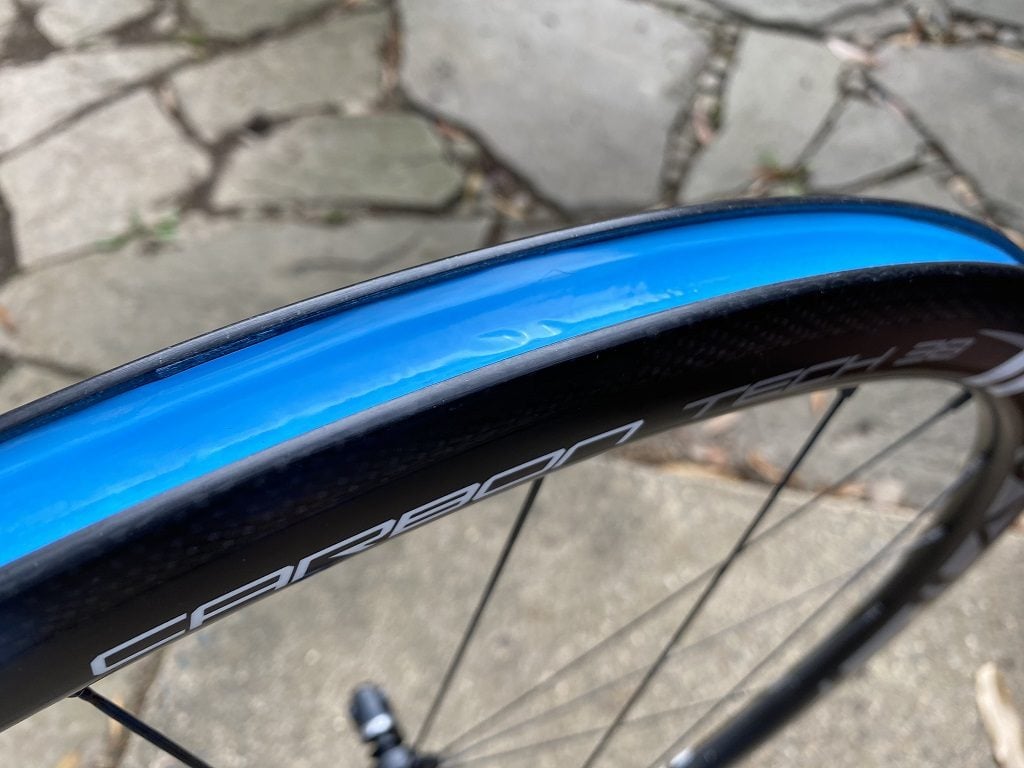 Paranoia insurance: A double layer of rim tape
Paranoia insurance: A double layer of rim tape
The other thing I did out of an abundance of paranoia is put a small piece of Gorilla duct tape over the valve stem hole. Why? Because when you install the valve stem, you have to create a seal on the inside of the rim by screwing the valve stem in place with the nut that I ordinarily just throw away when installing a tube on a regular set of clinchers. I don’t know about y’all, but I’m not particularly keen about the idea of a metal nut being cinched down onto my carbon clincher rims.
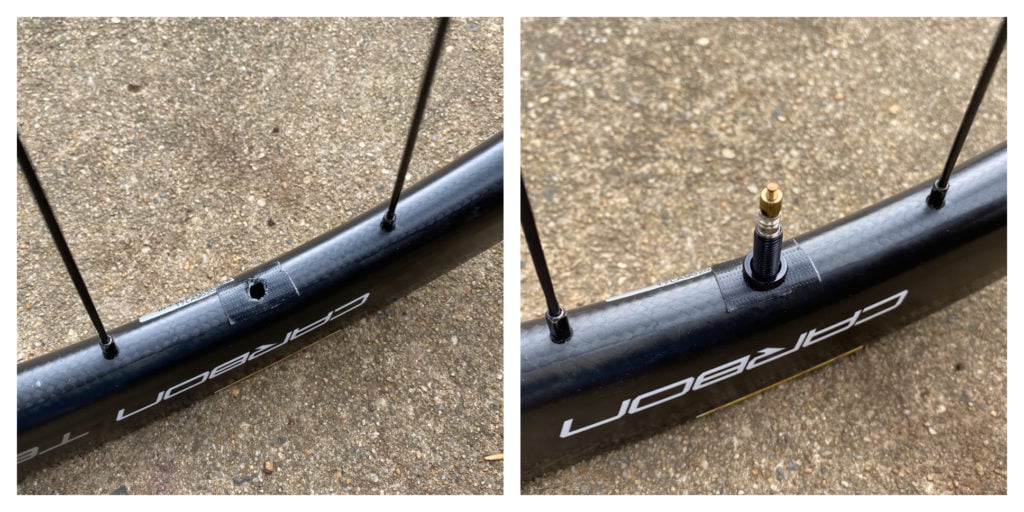 More paranoia insurance: Gorilla tape to prevent possible damage to carbon fiber
More paranoia insurance: Gorilla tape to prevent possible damage to carbon fiber
Speaking of cinching down, Continental’s website says: “Only tighten the nut by hand, do not use any tools.” My experience is that for the valve stem gasket to create an air tight seal on the inside of the rim, more than hand tight is necessary. And the recommendation from my LBS was to use a pair of needle-nose pliers to be able to get the nut tight enough.
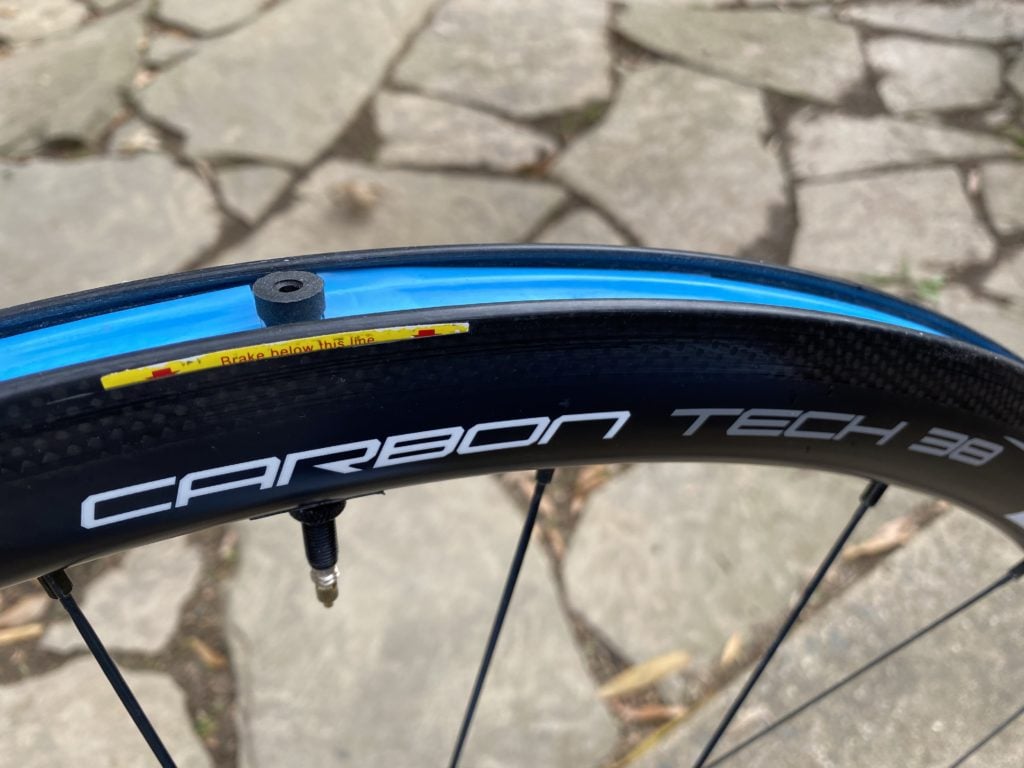 You’re going to need more than just hand tight
You’re going to need more than just hand tight
Installing the tires onto the rims is just like installing regular clincher tires except there’s no tube. One review I read claimed the Continental Grand Prix 5000 tubeless tires “are among the easiest to fit.” Personally, I didn’t find that to be the case. Actually, quite the opposite. And I’m not the only one. Another review described getting the tires onto a pair of rims as a process “accompanied by thumb skimming and swearing.”
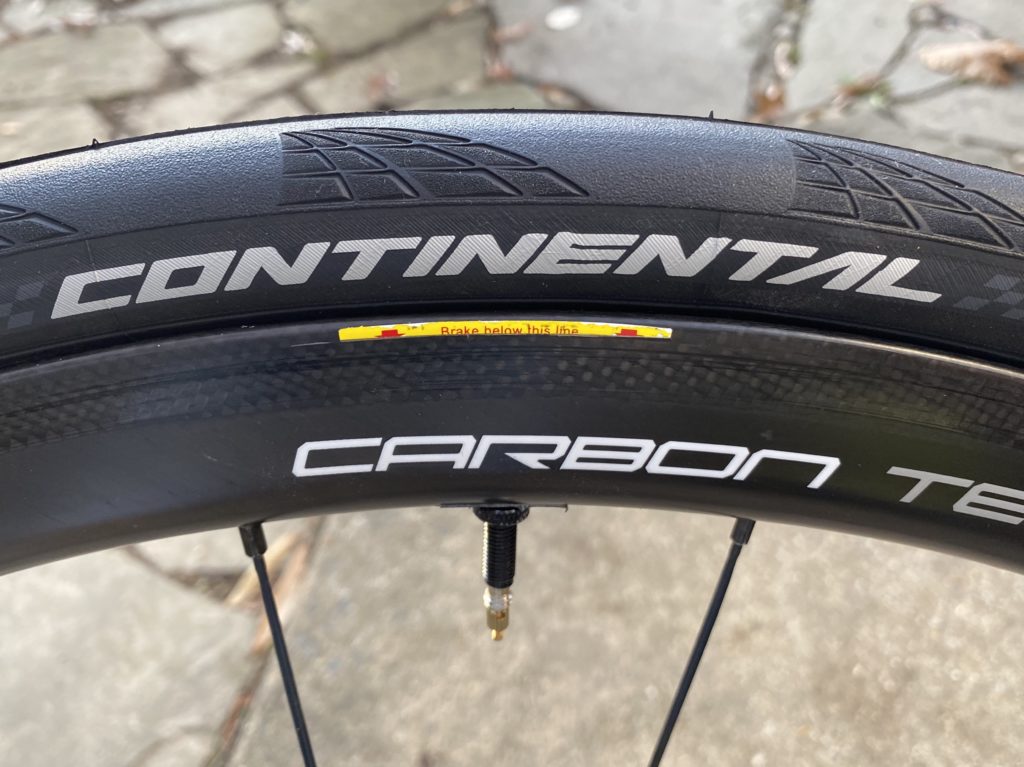 For that EuroPro look, line the valve stem and tire logo up with each other
For that EuroPro look, line the valve stem and tire logo up with each other
Seating the tires
Once the tires are on the rims, they need to be seated. With many tubeless tires this requires either a compressor or a special pump that has a secondary chamber that you can pump air into and then release it all at once to create enough pressure/force to seat the beads. There are also cannisters that you can pump up with a floor pump that do the same thing. You could also use a CO2 cartridge but that seems like a waste of a perfectly good CO2 cartridge, so something I would only do as a last resort.
But much to my surprise, I was able to seat the tires with a regular floor/track pump! This is a testament to the seal created by the ultra tight beads (so I guess worth the struggle installing). You know your beads are seated when you hear a distinctive “pop” as you pump up the tire. Even after you hear the first pop, keep pumping and you’ll like hear one or two more. How much air should you put in your tires? I’m running the Grand Prix 5000 TLs 700×28 and Continental recommends a maximum of 94 psi. I pumped them up to 100 psi to get them seated.
INTERESTING ASIDE: One of my riding buddies also wanted to go tubeless with the Continental GP 5000 TLs. He has a compressor, but couldn’t get the tires to seat on his carbon fiber wheels (name brand, but I won’t name the brand). He even took them to his LBS and they wouldn’t seat. I don’t know why, but very weird. And I’m sure he hates me for being able to seat mine with a floor pump.
Sealant
Instead of a tube, what goes inside a tubeless tire is sealant. The sealant does two things: (1) fills in any micro-porous areas between the bead and the rim and (2) seals most punctures while riding to prevent flats.
ANOTHER ASIDE: Supposedly, the Grand Prix 5000 TLs will hold air even without sealant. My experience was that after pumping them up to 100 psi and letting them sit overnight, they lost a few psi (about what you would expect for tires with sealant). So you could theoretically ride without sealant. Regardless, you’re going to want sealant to prevent flats (sort of the whole point of going tubeless).
Continental recommends using their RevoSealant, which is ammonium- and protein-free so it won’t chemically corrode the tire or tube. I can’t say what the best sealant is, but know that Stan’s and Orange Seal are popular and highly regarded. I decided to go with Effetto Mariposa Caffelatex sealant. One thing that sets Caffelatex sealant apart from other sealants is that it’s a liquid like other sealants but “foams up” when agitated (like the spinning of the wheel) and is supposed to coat the inside of the tire more thoroughly – especially the sidewalls – for more thorough puncture protection. After at rest for a while, it returns to its liquid state.
Like other sealants, Caffelatex sealant becomes solid when exposed to evaporation, repairing holes in the process. Effeto Mariposa claims that Caffelatex can seal punctures up to 3mm on road tires, which is about the same as with other sealants. And like other sealants, Caffelatex needs to be replenished periodically since sealant dries over time (the wheels/tires will still be airtight but if the sealant isn’t in a liquid state it won’t repair punctures). The expected lifespan of Caffelatex is 1-4 months and Effeto Mariposa recommends checking every 2 months to make sure the sealant is still liquid. Whatever sealant you use, check the manufacturer recommendations for how often to “top off.”
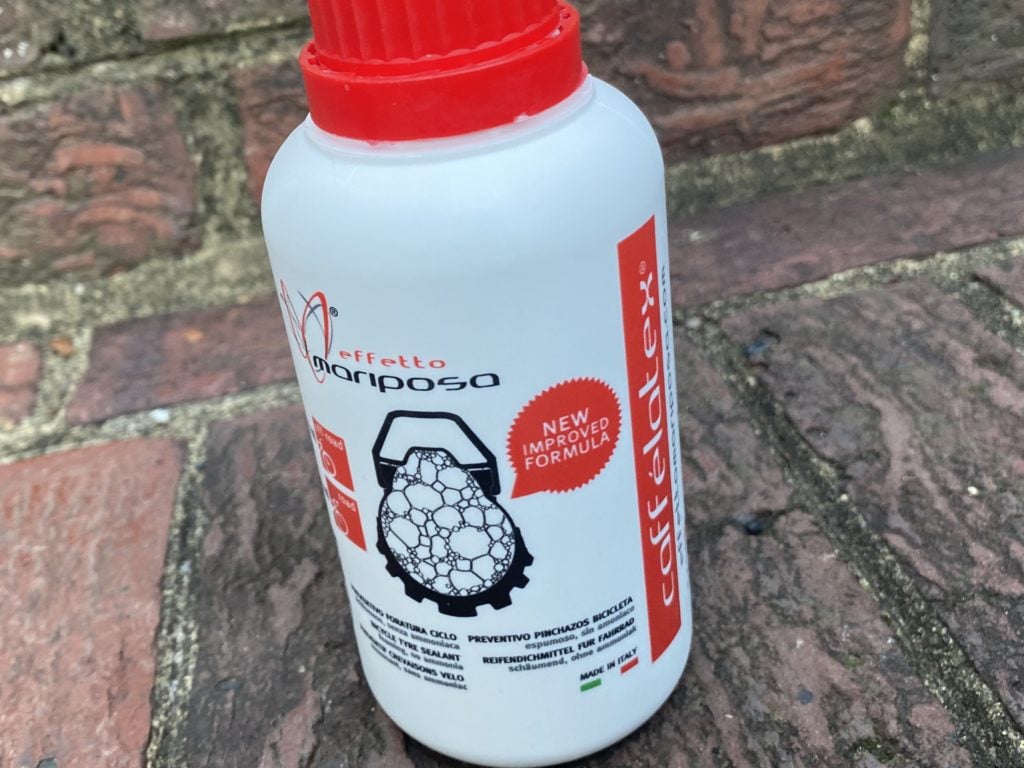 Sealant that gets fizzy when the wheel spins
Sealant that gets fizzy when the wheel spins
How much sealant to use is a function of tire width. Effetto Mariposa actually has an app to determine how much based on tire size. According to the app, 35 mL for 28mm.
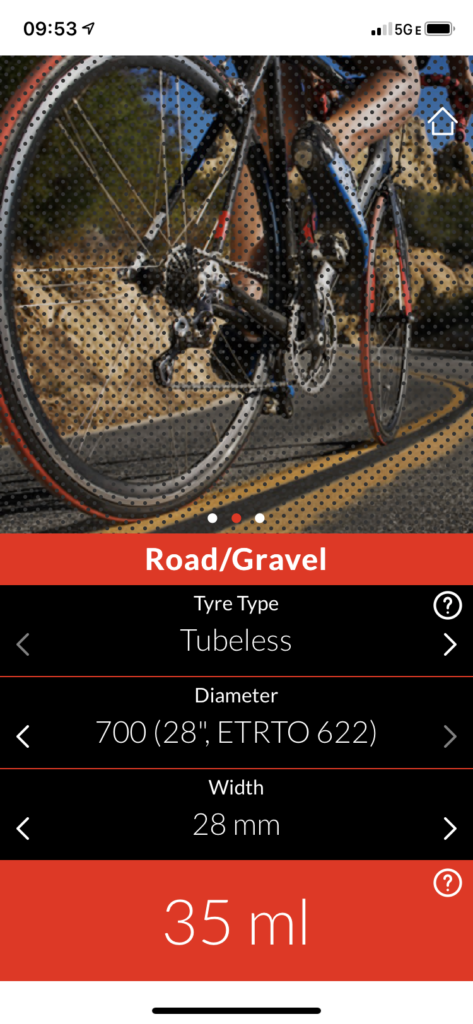
There’s an app for that!
It’s possible to put sealant in the tire before you install it by pouring in the measured amount before you pull the last bit of bead over the rim. However, given how tight the Grand Prix 5000 TL beads are (at least in my experience), I wouldn’t recommend doing this. Moreover, you’d be doing this before seating the tires and if you have any issues pumping them up to seat (especially with a compressor), you run the risk of having sealant spray everywhere.
Instead, use a syringe/injector to put sealant in through the valve stem after the tire is seated. There are a number of different syringes/injectors specifically for tire sealant. Some have plastic tubing that goes over the valve stem. Others have a thinner plastic tube that fits inside the valve stem and goes into the rim (NOTE that I have one of those but the tubing won’t fit through the gasket hole to go inside the rim on my Irwin valve stems.) And others screw onto the valve stem. I suppose they all have their relatively minor pros and cons, but use whatever type is going to work best for you. Since I’m using Effetto Mariposa Caffelatex sealant I’m matchy-matchy with the Effetto Mariposa syringe/injector.
Before you inject sealant you’ll need to remove the valve core, which requires a special valve core removal tool (ANOTHER ASIDE: Spend the extra $$$ for an alloy tool; IMHO the plastic ones are crap). Doing this will, of course, let all the air out of the tire. Just don’t “pinch” the sides of the tire afterwards because you’ll likely unseat the tire.
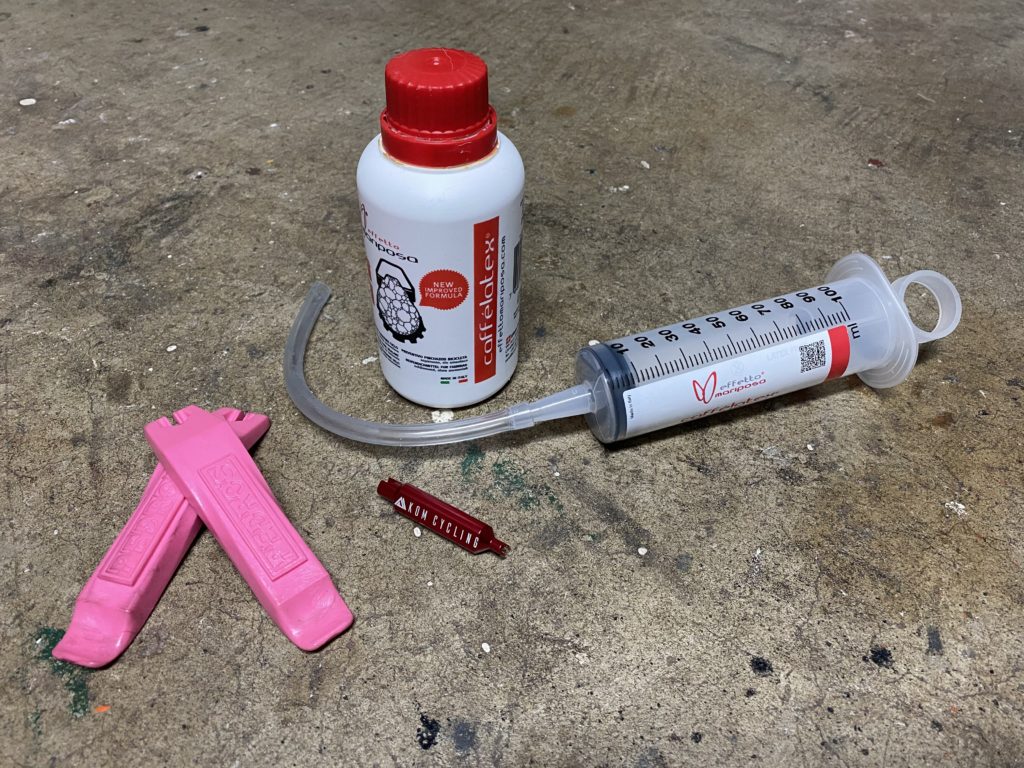 Tools of the trade for going tubeless: stout pair of tire levers, valve core removal tool, syringe/injector, and sealant
Tools of the trade for going tubeless: stout pair of tire levers, valve core removal tool, syringe/injector, and sealant
Attach the tubing of the syringe to the valve stem and push the syringe plunger to put sealant into the tire. A few “pro tips” to help make this process easier:
- I used my Park professional wheel truing stand (an older version of the TS-2.2) to hold my wheel as a “third hand” to hold the wheel in place.
- Put the valve stem at either the 7/8 o’clock or 4/5 o’clock position so that when you inject sealant it can flow to the bottom of the tire without potentially coming back up the valve stem.
- After injecting the sealant, slowly remove the plunger from the syringe. When the air seal is “broken,” whatever sealant is still in the tubing will flow out and into the valve stem and the tire. This also reduces/eliminates the possibility of back pressure when you remove the tubing and having sealant pulled back out of the valve stem.
Just don’t rush this part. Take your time, especially removing the tubing from the valve stem. Expect a little spill/a few drops (but not a lot) and pay attention to the orientation of the tubing and the syringe to minimize this. And don’t forget to wash out the syringe afterwards.
Reinstall the valve core (make sure you tighten it down snugly) and then just do what you do with any other tire … inflate it. (ANOTHER “PRO TIP”: Inflate the tire with the valve stem at the 12 o’clock position. That way, the air is going into the tire opposite the sealant and you reduce the likelihood of potential sealant spray outside the tire.) You might notice some sealant “leak” between the tire and the rim (not the case with the Grand Prix 5000s, which gives you some idea of how good/tight the seal is between the tire and rim). This is perfectly normal as it is filling any miniscule gaps that need to be sealed. Just wipe the sealant off. And then spin the wheel so that the sealant fully coats the inside of the tire.
Voila! Tu es fini! Go ride!
Riding tubeless
I had previously ridden regular Continental Grand Prix 5000 clinchers (700×25) for about 1,500 miles and was very happy with them. My experience with them was that they were fast, grippy, nimble, stable, and composed over less than smooth pavement. For what is considered a “go fast” tire, they were a firm but surprisingly comfortable-ish enough ride. Not plush, but not harsh either. So that’s my point of reference.
One of the benefits of tubeless is the ability to ride lower tire pressures. I usually ride 700×25 clinchers with 76 psi in the front and 80 psi in the rear, which are relatively low pressures to start. Since I’m riding the GP 5000 TLs wider at 700×28, I decided to run even lower tire pressures: 72 psi front and 76 psi rear.
I should also mention that I’m riding the 5000 TLs on my Irwin AON TLR 38 carbon clincher rims fitted to my early 90s era (but now retro-mod) #steelisreal Hollands, which is custom frame built with Reynolds 653 tubing (Kinesis carbon fork) and used to be my race bike. At the above tire pressures, the 700x28s fit but only just (I admit that I took a bit of a risk going 700×28 instead of sticking with 700×25, but I’ve ridden 700x28s on my Hollands before so crossed my fingers that the 5000s wouldn’t be too wide).
 Modern wheels/tires on a “retro” #steelisreal bike (BTW, that’s the new Marque Hex bar tape). And yes, that’s a downtube front shifter … I copied Andy Hampsten’s set-up after he won on Alpe d’Huez in 1992 (yes, I’m old!)
Modern wheels/tires on a “retro” #steelisreal bike (BTW, that’s the new Marque Hex bar tape). And yes, that’s a downtube front shifter … I copied Andy Hampsten’s set-up after he won on Alpe d’Huez in 1992 (yes, I’m old!)
Given that Grand Prix 5000 clinchers were a fast ride, I expected the same with the tubeless version. And that was the case. Is tubeless faster? That I can’t say. I don’t have any way to make actual measurements, but my seat-of-the-pants (or is that chamois?) meter tells me that the rolling resistance is exceptionally low. If you want actual data, Jarno Bierman has some for you.
As I’ve installed the 5000 TLs just before the onset of winter, my initial riding has been in cold temps (30s and 40s F). With cold pavement and lower tire temps, you have to expect less grip than you would in warmer weather. That said, my experience was no slip and plenty of grip. Whether it was railing through a corner pretending I was in a crit, making fast left/right or right/left transitions pretending to avoid an errant pedestrian with their face glued to their screen and wearing headphones, or bombing down a hill in an aero tuck pretending to be Vincenzo Nibali descending the Poggio in Milan-SanRemo or the Civiglio in Il Lombardia, I had no issues with traction.
On less than smooth pavement, the ride is pretty plush. A large part of that is probably due to 700×28 at lower tire pressures, but you also expect tubeless tires to be more comfortable than clinchers. So whether it was riding over cracked or otherwise broken up pavement, seams and joints resulting in uneven pavement, bricked roadway, slightly raised or dipped manhole covers, minor curbing, and small holes where chunks of pavement had come off (but not any big potholes), the Grand Prix 5000 TLs considerably softened the inevitable hit. As a result, I never felt like I was getting bounced off. Words that describe the feeling are “stable,” “confident,” “controlled,” and “composed.”
But compared to the clincher version, the Continental GP 5000 TLs are like a revelation. Not only is the ride uber comfortable (especially in 700×28), but also incredibly smooth. It’s about as close to the ever elusive feeling of riding tubulars (what I used to ride exclusively way back in the day when I was still racing). It’s hard to describe the difference between clincher and tubeless, but the best way I can characterize the ride is that it’s a sensation of floating on the tarmac. My friend Nick Clark, who owns LBS ProBike FC and is still riding tubulars, agrees with me (he finished 3rd in the 1993 Worlds Men’s Junior Road Race and raced professionally for Chazal and Petit Casino AG2R so is no slouch!)
 Always great fun to ride and hang out with my mate, Nick Clark. No man left behind!
Always great fun to ride and hang out with my mate, Nick Clark. No man left behind!
What I can’t attest to is how the Grand Prix 5000 TLs will wear over time. Since they’re more of a “go fast” tire, they aren’t necessarily built for high mileage endurance/longevity. That said, I had about 1,500 miles on my Grand Prix 5000 clinchers before I swapped them out to test ride another set of tires (Pirelli Cinturato Velos) and they still had plenty of life in them (probably could’ve ridden them for at least another 1,500 miles). Given that the TL is essentially the same tire (same materials and design), I would expect to get similar results.
And I can’t attest to how well the Grand Prix 5000 TLs ward off flats or seal punctures. But I’m hoping that going tubeless doesn’t change my luck for the worse.
Ride quality like tubulars. Comfortable. Fast. Grippy. Nimble. Stable. Composed. And potentially no flats (fingers crossed). What’s not to like?
And then there’s this compelling reason: No more saddle bag to carry a spare tube, tire levers, and CO2 cartridge.
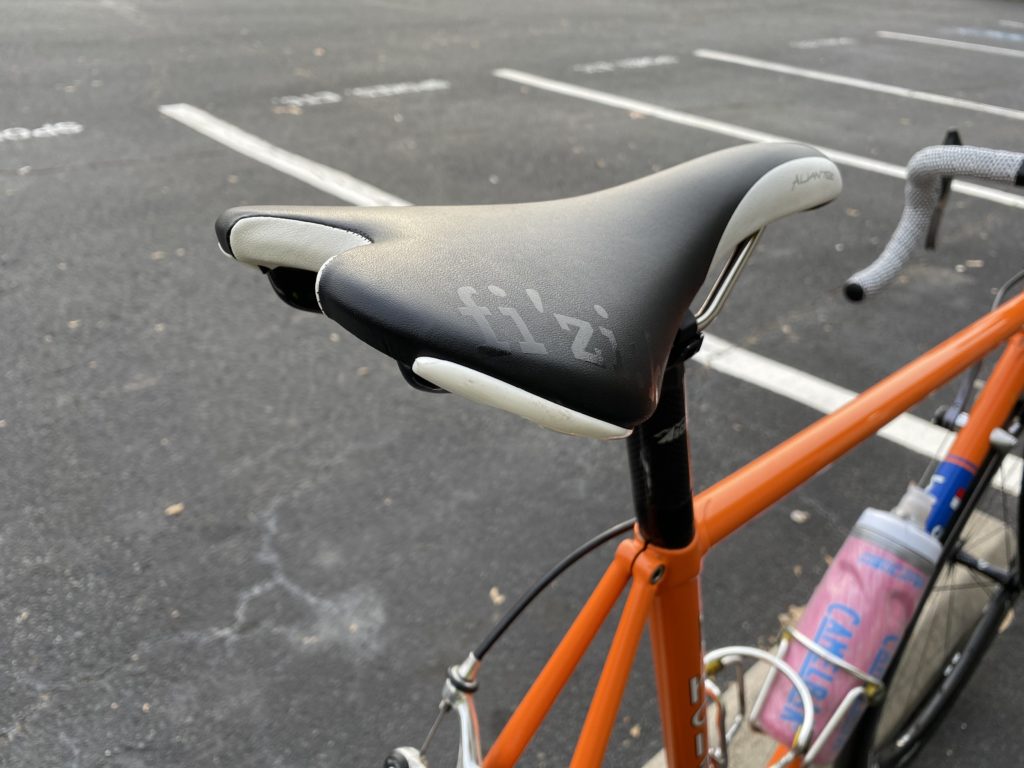 Vanity is the real reason to go tubeless … no more saddle bag!
Vanity is the real reason to go tubeless … no more saddle bag!
More on the AON TLR Carbon Road Bike Wheels
More on the Continental GP 5000 Tubeless Tires
